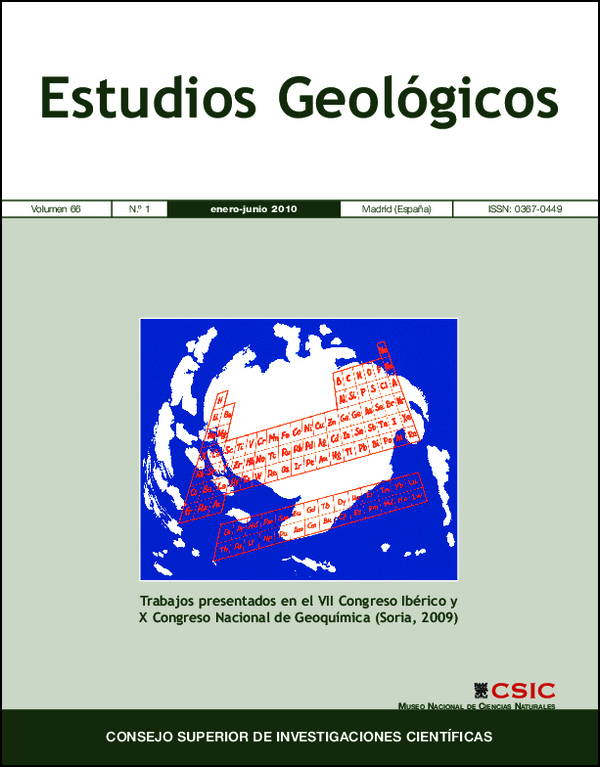Assessment of the alkali-silica reactivity in siliceous aggregates and minimization alternatives
DOI:
https://doi.org/10.3989/egeol.40143.095Keywords:
siliceous aggregates, alkali-silica reaction, SEM, ground clay brickAbstract
Siliceous aggregates are characterized for presenting certain chemical reactivity opposite to the calcium hydroxide liberated in the hydration of the Portland cement. The consequence of this reaction between the aggregate and the components of the intermediate concrete phase is the formation of gels very eager for water that can generate important disruptive pressures in the deeper structure of concrete. We have assessed the potential reactivity of several siliceous aggregates (granites, gneiss, hornfels, granites, quartzite and serpentine) by means of the accelerated method in concrete bars (normalized method) and the superficial reactivity method, observing by scanning electron microscopy (SEM) the formation of silica calcium alkaline gels. On the other hand, we explore the way of minimizing this disruptive reaction employing ground clay bricks and cement type CEM IV UNE-EN 197-1.
Downloads
References
Ben Haha, M.; Gallucci, E.; Guidoum, A. & Scrivener, K.L. (2007). Relation of expansion due to alkali silica reaction to the degree of reaction measured by SEM image analysis. Cement and Concrete Research, 37: 1206-1214. doi:10.1016/j.cemconres.2007.04.016
Berube, M.A. (2002). Laboratory assessment of alkali contribution by aggregates to concrete and application to concrete structures affected by alkali-silica reactivity Cement and Concrete Research, 32: 1215-1227. doi:10.1016/S0008-8846(02)00766-4
Gavrilenko, E.; García del Amo, D.; Calvo Pérez, B. & García García, E. (2007). Comparison of ASR-gels in concretes against accelerated mortar bar test samples. Magazine of Concrete Research, 59: 483-494. doi:10.1680/macr.2007.59.7.483
Hobbs, D.W. (1988). Alkali-silica reaction in concrete. Ed. Thomas Telford, London, 192 págs.
Leemann, A. & Holzer. L. (2005). Alkali-aggregate reaction. Identifying reactive silicates in complex aggregates by ESEM observation of dissolution features. Cement and Concrete Composites, 27: 796-801. doi:10.1016/j.cemconcomp.2005.03.007
Li, X.H. & Gress. D.L. (2006). Mitigating alkali-silica reaction in concrete containing recycled concrete aggregate. Transportation Research Record, 1979: 30-35. doi:10.3141/1979-06
Mather, B. (1999). How to make concrete that will not suffer deleterious alkali-silica reaction. Cement and Concrete Research, 29: 1277-1280. doi:10.1016/S0008-8846(98)00240-3
Menéndez, E. & Soriano, J. (2007). Procesos expansivos del hormigón: ensayos árido-álcali, ataque por sulfatos, hielo deshielo. Sistemas de prevención y actuaciones. Curso de Estudios Mayores de la Construcción, 17 edición. Instituto Eduardo Torroja, CSIC, Madrid.
Chrest, A.P.; Brown, R.; Breeze, P.C.; Clarke, J.L.F.; D’arcy, T.J.; Durning, T.; Eddy, D.B.; Gami, S.S.; Iverson, P.J.; Magnesio, C.; Meinheit, D.F.; Nadeau, F.A.; Peterson, C.A.; Rear, K.; Schupack, M. & Walker, H.C. (1994). Alkali-aggregate reactivity: a summary. PCI Journal, 39: 26-35.
Soriano, J. (1980). Influencia de la naturaleza mineralógica de adiciones en el comportamiento de la pasta endurecida de cemento Portland. Revista de Obras Públicas, 127: 861-867.
Soriano, J. (1996). Aplicación del MEB al estudio de materiales de construcción. En: Microscopía electrónica de barrido y microanálisis por rayos X (Aballe, M.; López-Ruiz, J.; Badía, J.M. & Adeva, P., eds.), Ed. Rueda, Madrid, 111-111.
Stanton, T.E. (1948). Correlation of laboratory tests with field experiences of excessive concrete expansion induced by a reaction between the cement and aggregate. Proceedings American Society for Testing and Materials, 48: 1057-1066.
Thomas, M.D.A.; Hooton, R.D. & and Rogers. C.A. (1997). Prevention of damage due to alkali-aggregate reaction (AAR) in concrete construction. Canadian approach. Cement Concrete and Aggregates, 19: 26-30. doi:10.1520/CCA10018J
Turanli, L.; Bektas, F. & Monteiro, P.J.M. (2003). Use of ground clay brick as a pozzolanic material to reduce the alkali-silica reaction. Cement and Concrete Research, 33: 1539-1542. doi:10.1016/S0008-8846(03)00101-7
Downloads
Published
How to Cite
Issue
Section
License
Copyright (c) 2010 Consejo Superior de Investigaciones Científicas (CSIC)

This work is licensed under a Creative Commons Attribution 4.0 International License.
© CSIC. Manuscripts published in both the print and online versions of this journal are the property of the Consejo Superior de Investigaciones Científicas, and quoting this source is a requirement for any partial or full reproduction.
All contents of this electronic edition, except where otherwise noted, are distributed under a Creative Commons Attribution 4.0 International (CC BY 4.0) licence. You may read the basic information and the legal text of the licence. The indication of the CC BY 4.0 licence must be expressly stated in this way when necessary.
Self-archiving in repositories, personal webpages or similar, of any version other than the final version of the work produced by the publisher, is not allowed.















